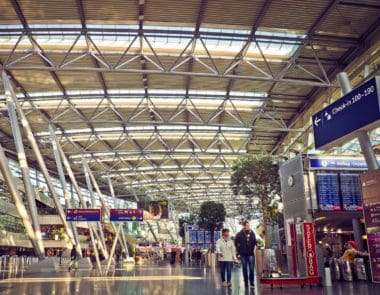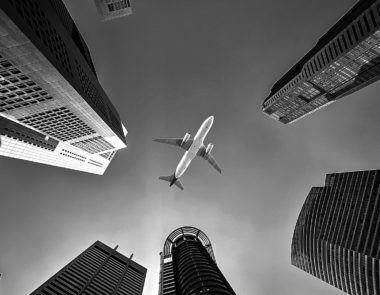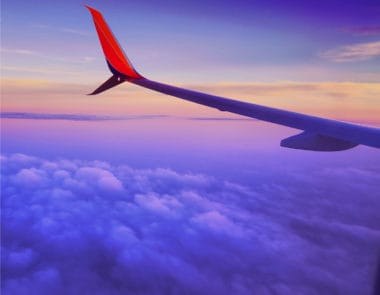How to Avoid Airline Flight Delays & Cancellations in 2025
It feels like there is another airline meltdown every week. Between cancellations and significant delays, United States air travelers have recently dealt with unprecedented flight disruptions. And while you cannot guarantee a smooth and on-time flight, there are things you can do to better your odds. Per our 2024 Thanksgiving Travel Survey and 2024 Christmas Travel Survey, nearly 46% of American adults say they have little or no confidence in airlines being able to avoid excessive delays and cancellations this holiday season!
We briefly hit on this in our What To Do if Your Airline Cancels or Delays Your Flight guide, but this article will take a deeper dive. Here are our tips for avoiding flight delays and cancellations.
Table of Contents
Select the Earliest Flight Possible
Most people do not like taking 8 a.m. flights or earlier; That is good news for you. Not only are very early morning flights cheaper, but they are also less likely to experience a cancellation or significant delay.
Cancellations and delays often amplify throughout the day. That means an early morning delay is often shorter than one later in the day. Additionally, your odds of securing another same-day flight from a morning cancellation are higher than if your late afternoon or evening flight was canceled.
Opt for flights taking off before 8 a.m. If that is too early, shoot for something before noon. But remember, the earlier the better.
We recommend using Google Flights to quick find early departure times for a variety of different airlines.
Further Reading: How to Find Cheap Flights, Best Days of the Week to Book Flights, & Best & Worst Times of Day to Fly.
Select Nonstop Flights Over Those With Connections
Assuming the price difference is reasonable, always book nonstop flights over ones with layovers. Unfortunately, having a layover opens the door to multiple problems.
- Your First Flight is Delayed or Canceled
- Your Second Flight is Delayed or Canceled
- One or Both of Your Flights are Changed
The worst-case scenario is if your first leg is delayed or canceled. Even a small delay could mean missing your second leg if the layover is short. If your first flight is canceled, then you have to go through the process of finding two new flights. It is not as bad if your second leg is delayed or canceled, but it is still something to avoid.
Another issue is your airline changing one or both of your flights. Usually, the airline will change it so you can still make your connection, but that is not always the case. American Airlines recently switched the first leg of my upcoming flight (I cannot always follow my own advice!), and the layover went from two hours to only 40 minutes. Unfortunately, that short of a layover leaves little time for any delay.
And it can be much worse if your layover involves two different airlines. At least with the same airline, it will be aware of your itinerary. If another airline is involved, you may be out of luck if one of your legs is changed. If your itinerary is with one airline, your second flight will most likely be in the same terminal that you landed in. With two different airlines, it could be a different terminal that takes a long time to get to.
If You Can’t Avoid a Layover, Ensure it is at Least 90 Minutes
Layovers are no fun, but they are important. Unfortunately, we are at the point where I recommend opting for a longer one. At the minimum, only book flights with layovers of at least 90 minutes. If possible, shoot for two hours to two and a half hours. That betters your odds of catching the second leg if your first leg is delayed. But the rule still stands — Only Book Nonstop Flights if Possible.
The Vacationer Tip
See if your credit card offer free lounge access to make long layovers more bearable.
Consider the Typical Weather at Both Airports
Considering flying from Minneapolis–Saint Paul International Airport to Chicago O’Hare International Airport in the middle of February? Do not be surprised if bad weather delays or cancels your flight. Account for the average weather at both your departing and arriving airport before booking during the month of your flight.
It is always a guessing game, but consider things like snow and extreme heat. I had a flight significantly delayed out of Phoenix Sky Harbor International Airport a few summers ago because of high temperatures.
If you do risk it, monitor the weather as your travel day approaches. If it looks bad, check your options for changing your flight to another day. Most airlines no longer have change fees (except on basic economy fares). During severe events, many airlines offer weather waives. These waivers allow you to change your flight without potentially paying change fees or fare differences.
Further Reading: Flight Cancellations & Delays Due to Bad Weather
Fly During Less Busy Times of the Year
The more people flying, the greater the odds of things going wrong. I recommend flying during times when most people are not. That includes peak summer months and around the holidays. Airlines always struggle with cancellations and delays during busy times.
For the holidays, consider driving or flying earlier or later than the usual times. For the summer, consider driving or flying during the shoulder season. That includes late May through the middle of June and late August through the Middle of September. During that time, fewer people are flying but it is still warm enough in most United States cities to enjoy summer activities.
Further Reading: How to Find Cheap Summer Flights
Make Sure Your Airline Flies Your Route Often
Check how often your airline flies your route. It can range from multiple times per day to once a week; The more, the better. If your flight experiences a cancellation or delay, it will be easier to book an alternative flight to potentially shorten your delay.
I once flew direct from LaGuardia Airport to Glacier Park International Airport. At the time, this route only flew once per week in the summer. While I could have booked a flight from my home airport in Philadelphia, I did not want a layover. Instead, I did take a risk by booking the direct flight from LaGuardia. If it had gotten canceled or significantly delayed, my options would have been limited.
Fly From Hubs
In addition to ensuring your airline flies your route multiple times per day, I also recommend flying from hubs. A hub is an airport where an airline flies to and from on a large scale. Generally, an airline is better equipped to handle delays and cancellations at one of its hub airports. For example, if you fly from Dallas/Fort Worth or Philadelphia, you have a pretty good chance of flying with American Airlines since they are both hub airports.
Living near Philadelphia, I try to fly American Airlines since it has a hub there. I recommend checking which airlines have hubs at your nearest airport.
Fly on Less Busy Days
Typically, Tuesdays and Wednesdays are the best days of the week to fly. Fewer people fly on those days, which means better odds your flight departs and arrives on time. Additionally, those days are often cheaper than other days.
Further Reading: The Best Days of the Week to Fly and The Best Days of the Week to Fly for the Holidays.
Avoid Airlines That Struggle With Frequent Delays & Cancellations
Some airlines struggle with delays and cancellations more than others. Here is recent data from the Bureau of Transportation Statistics showing the airlines with the most delays and cancellations as of November 30, 2022.
| Airline | Percent Delayed (min. 15 minutes) | Percent Canceled |
|---|---|---|
| Allegiant Air | 33.38% | 2.63% |
| Frontier Airlines | 30.76% | 2.34% |
| JetBlue | 30.52% | 3.19% |
| Southwest Airlines | 24.36% | 1.54% |
| Spirit Airlines | 23.12% | 2.72% |
| Hawaiian Airlines | 22.89% | 0.39% |
| American Airlines | 19.81% | 2.12% |
| United Airlines | 17.33% | 1.86% |
| Alaska Airlines | 17.23% | 1.25% |
| Delta Air Lines | 15.38% | 1.60% |
As the table shows, low-cost carriers like Allegiant, Frontier, and Spirit struggle with delays and cancellations more than airlines like Delta, Alaska, and United. Allegiant, especially, because over one-third of its flights are delayed, with another 2.63% canceled. Out of the three major United States airlines, American Airlines is worse than both United Airlines and Delta Air Lines when it comes to delays and cancellations.
Despite Southwest Airlines’ holiday season 2022 meltdown, it is actually on the lower end for cancellations. For delays, however, it has the fourth most from our sample.
The Vacationer Tip
Our What To Do if Your Airline Cancels or Delays Your Flight guide details what to do if your flight is canceled or delayed. This includes measures to take for quickly finding a new flight and refund options. Our How to Get Compensation From Your Airline When Your Flight is Delayed or Canceled details what each airline offers for controllable flight interruptions.
Avoid Airports With High Levels of Delays & Cancellations
Some airports struggle with cancellations and delays more than others, so you should keep that in mind when planning your next flight. Here is data from FlightAware showing the airports with the most delays and cancellations from May 27, 2022, through September 5, 2022.
| Airport | Percent Delayed |
|---|---|
| Chicago Midway International Airport | 37.7% |
| Baltimore/Washington International Airport | 32.5% |
| Orlando International Airport | 32.2% |
| John F. Kennedy International Airport | 31% |
| Harry Reid International Airport | 31% |
Additionally, Newark Liberty International Airport, Dallas Love Field Airport, Dallas Fort Worth International Airport, Denver International Airport, and Charlotte Douglas International Airport all had delay percentages of at least 27%.
| Airport | Percent Canceled |
|---|---|
| Newark Liberty International Airport | 6.7% |
| LaGuardia Airport | 6.7% |
| Reagan National Airport | 4.8% |
| Raleigh-Durham International Airport | 3.7% |
| Cleveland Hopkins International Airport | 3.5% |
Additionally, Pittsburgh International Airport, Boston Logan International Airport, John Glenn Columbus International Airport, Cincinnati/Northern Kentucky International Airport, and Indianapolis International Airport all had cancellation percentages of at least 2.9%.
What to Do if Your Flight is Delayed or Canceled?
This article detailed how to avoid a flight delay or cancellation, but there are measures you can take if you experience a cancellation or significant delay. See the best ways to monitor for flight delays and cancellations as well as actions to take in the event of a flight delay or cancellation.
Also read our guide on How to Get Compensation From Your Airline When Your Flight is Delayed or Canceled
What Causes Flight Delays and Cancellations?
Most delays and cancellations are caused by these factors.
- Poor Weather
- Mechanical Issues
- Staffing Issues
- Very High Demand
Poor weather actually accounts for a very small percentage of delays and cancellations. You should take it into account, but your airline, airport, and the time of year are more important for taking off on schedule.
FAQ
Here are our tips for avoiding flight delays in cancellations.
1. Select the Earliest Flight Possible
2. Select Nonstop Flights Over Those With Connections
3. If You Can’t Avoid a Layover, Ensure it is at Least 90 Minutes
4. Consider the Typical Weather at Both Airports
5. Fly During Less Busy Times of the Year
6. Make Sure Your Airline Flies Your Route Often
7. Fly From Hubs
8. Fly on Less Busy Days
9. Avoid Airlines That Struggle With Frequent Delays & Cancellations
10. Avoid Airports With High Levels of Delays & Cancellations
Unfortunately, these tips will only minimize your chances of experiencing a delay or cancellation. There is nothing you can to do 100% guarantee an on-time departure and arrival.
Yes, it does. Generally, it is better to fly early in the morning to lessen your chances of disruption.
It is extremely important. Always opt for a longer layover in case your first flight is delayed.
It does. Generally, holidays and other busy travel periods like the summer experience more flight delays and cancellations. Instead, fly during non-peak times of the year. Additionally, Tuesday and Wednesday flights are typically less likely to get canceled than on busy days like Monday and Friday.
The Vacationer’s Final Thoughts
When traveling, nothing is worse than starting or ending a trip with a flight cancellation or significant delay. While our tips are not foolproof, they are likely to improve your odds of experiencing on-time flights; I follow them every time I book a flight. The two most important things you can do are book an early morning flight with no layovers. As detailed in the article, early-morning flights experience significantly fewer cancellations than those later in the day. Additionally, nonstop flights have fewer legs, which means fewer things can go wrong.
Get The Vacationer Newsletter
Get highlights of the most important news delivered to your email inbox





